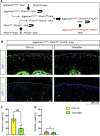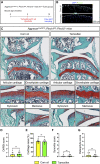Brief research report: Effects of Pinch deficiency on cartilage homeostasis in adult mice
- PMID: 36743414
- PMCID: PMC9892552
- DOI: 10.3389/fcell.2023.1116128
Brief research report: Effects of Pinch deficiency on cartilage homeostasis in adult mice
Abstract
Pinch1 and Pinch2 are LIM domain-containing proteins with crucial functions in mediating focal adhesion formation. Our previous studies have demonstrated that Pinch1/2 expression is essential for cartilage and bone formation during skeletal development in mice. Loss of Pinch expression (Prx1Cre; Pinch1flox/flox; Pinch2-/-) inhibits chondrocyte proliferation and promotes chondrocyte apoptosis, resulting in severe chondrodysplasia and limb shortening. Based on these observations, we wonder if Pinch proteins have a role in adult cartilage and whether Pinch deficiency will compromise cartilage homeostasis and promote osteoarthritis (OA)-related defects in adult mice. To this end, we generated the AggrecanCreERT2; Pinch1flox/flox; Pinch2-/- mice, in which the Pinch1 gene can be inducibly deleted in aggrecan-expressing chondrocytes by tamoxifen and the Pinch2 gene is globally inactivated. Immunofluorescent staining confirmed that the expression of Pinch proteins was significantly decreased in articular cartilage in tamoxifen-treated adult AggrecanCreERT2; Pinch1flox/flox; Pinch2-/- mice. Unexpectedly, our results showed that Pinch loss did not induce marked abnormalities in articular cartilage and other joint tissues in the knee joints of either adult (10-month-old) mice or aged (17-month-old) mice. In a destabilization of the medial meniscus (DMM)-induced OA model, the surgically-induced OA lesions were comparable between Pinch-deficient mice and control mice. Given the fact that Pinch proteins are essential for chondrogenesis and cartilage formation during skeletal development, these findings suggest that Pinch expression is seemingly not indispensable for adult cartilage homeostasis in mice.
Keywords: Pinch; articular cartilage; focal adhesion; homeostasis; osteoarthritis.
Copyright © 2023 Wu, Lin, Liao, Yao, Lin, Zou and Xiao.
Conflict of interest statement
The authors declare that the research was conducted in the absence of any commercial or financial relationships that could be construed as a potential conflict of interest. The handling editor DX declared a shared parent affiliation with the author(s) RL, LL at the time of review. The reviewer GH declared a shared parent affiliation with the author(s) RL, LL to the handling editor at the time of review. The reviewer FW declared a shared parent affiliation with the author(s) SL, XZ to the handling editor at the time of review.
Figures




Similar articles
-
Loss of Pinch Proteins Causes Severe Degenerative Disc Disease-Like Lesions in Mice.Aging Dis. 2023 Oct 1;14(5):1818-1833. doi: 10.14336/AD.2023.0212. Aging Dis. 2023. PMID: 37196110 Free PMC article.
-
LIM domain proteins Pinch1/2 regulate chondrogenesis and bone mass in mice.Bone Res. 2020 Oct 13;8:37. doi: 10.1038/s41413-020-00108-y. eCollection 2020. Bone Res. 2020. PMID: 33083097 Free PMC article.
-
Comparison of Kindlin-2 deficiency-stimulated osteoarthritis-like lesions induced by Prg4CreERT2 versus AggrecanCreERT2 transgene in mice.J Orthop Translat. 2023 May 31;41:12-19. doi: 10.1016/j.jot.2023.05.005. eCollection 2023 Jul. J Orthop Translat. 2023. PMID: 37292436 Free PMC article.
-
Consequences of loss of PINCH2 expression in mice.J Cell Sci. 2005 Dec 15;118(Pt 24):5899-910. doi: 10.1242/jcs.02686. Epub 2005 Nov 29. J Cell Sci. 2005. PMID: 16317048
-
Cartilage Homeostasis and Osteoarthritis.Int J Mol Sci. 2022 Jun 5;23(11):6316. doi: 10.3390/ijms23116316. Int J Mol Sci. 2022. PMID: 35682994 Free PMC article. Review.
Cited by
-
Loss of Pinch Proteins Causes Severe Degenerative Disc Disease-Like Lesions in Mice.Aging Dis. 2023 Oct 1;14(5):1818-1833. doi: 10.14336/AD.2023.0212. Aging Dis. 2023. PMID: 37196110 Free PMC article.
-
Inactivation of Tnf-α/Tnfr signaling attenuates progression of intervertebral disc degeneration in mice.JOR Spine. 2024 Oct 8;7(4):e70006. doi: 10.1002/jsp2.70006. eCollection 2024 Dec. JOR Spine. 2024. PMID: 39391171 Free PMC article.
-
Targeting Piezo1 channel to alleviate intervertebral disc degeneration.J Orthop Translat. 2025 Mar 8;51:145-158. doi: 10.1016/j.jot.2025.01.006. eCollection 2025 Mar. J Orthop Translat. 2025. PMID: 40129609 Free PMC article.
References
LinkOut - more resources
Full Text Sources
Molecular Biology Databases

